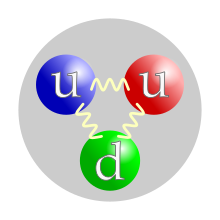
Baryons are composite particles made of three quarks, as opposed to mesons, which are composite particles made of one quark and one antiquark. Baryons and mesons are both hadrons, which are particles composed solely of quarks or both quarks and antiquarks. The term baryon is derived from the Greek "βαρύς" (barys), meaning "heavy", because, at the time of their naming, it was believed that baryons were characterized by having greater masses than other particles that were classed as matter.
Until a few years ago, it was believed that some experiments showed the existence of pentaquarks – baryons made of four quarks and one antiquark.[1][2] Prior to 2006 the particle physics community as a whole did not view the existence of pentaquarks as likely.[3] On 13 July 2015, the LHCb collaboration at CERN reported results consistent with pentaquark states in the decay of bottom lambda baryons (Λ0
b).[4]
Since baryons are composed of quarks, they participate in the strong interaction. Leptons, on the other hand, are not composed of quarks and as such do not participate in the strong interaction. The best known baryons are protons and neutrons, which make up most of the mass of the visible matter in the universe, whereas electrons, the other major component of atoms, are leptons. Each baryon has a corresponding antiparticle, known as an antibaryon, in which quarks are replaced by their corresponding antiquarks. For example, a proton is made of two up quarks and one down quark, while its corresponding antiparticle, the antiproton, is made of two up antiquarks and one down antiquark.
- ^ H. Muir (2003)
- ^ K. Carter (2003)
- ^ W.-M. Yao et al. (2006): Particle listings – Positive Theta
- ^ R. Aaij et al. (2015)